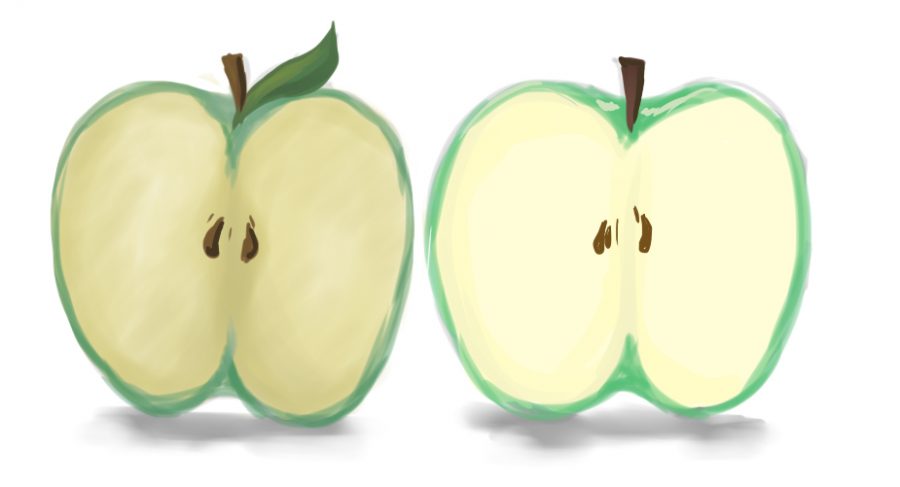When you’re perusing the produce aisle, your obvious choice is to reach for the shiny, red apple over the browning, shriveling one.
But what if you discover the red one’s actually been on the shelf longer? With the rise of genetically engineered crops, it’s more likely than you might think — and it’s not such a bad thing.
Companies like Chipotle have done little to contribute to a positive perception of genetic engineering in food. Publicity campaigns built around removing GMOs — genetically modified organisms — from the food they serve have succeeded at overshadowing any favorable exposure the topic has received.
Recently, researchers have developed a genetically modified apple with non-browning traits that resists spoiling for weeks.
Okanagan Specialty Fruits created and distributed the product after 20 years of research and product development, has been dubbed the “Arctic apple.” Following approval from the Federal Drug Administration of commercial sale, 500 boxes of pre-sliced apples are set to be test-trialed in 10 grocery stores across the Midwest, starting in early February.
These apples are a significant triumph for genetic engineering, as their output has the potential to significantly decrease food waste. With any luck, the Arctic apples will eliminate the need for other chemical additives to prevent browning.
When their skin is punctured, apples turn brown due to a protein called polyphenol oxidase, or PPO. This enzyme exists in many plant species and oxidizes the inside of the apple as a natural deterrence against pests.
Research from the United Nations Food and Agriculture Organization has found that PPO provides little to no benefit to the fruit’s cultivation. Thus, the Arctic apple’s producers impeded the generation of the enzyme in order to allow them to last up to three weeks without naturally undergoing oxidation.
While this scientific feat is impressive on its own, it readily lends itself to the much broader narrative that is the debate over GMOs.
The anti-GMO movement has been grounded in the belief that GMOs can be detrimental to human health, as well as the environment. But hundreds of studies have failed to find conclusive data suggesting negative health effects. A 2013 review of 1,783 of these independent studies on GMO safety and environmental effects found that not a single one linked the use of genetically modified food products with any significant safety issues.
Genetic engineering certainly has its drawbacks. Patents — private companies’ trademarking the newly created crops — and blights that devastate genetically identical plant populations are among the most notable. But the proven advantages of GMOs, like the increased productivity of heightened photosynthesis and crops’ self-fertilization, far outweigh these cons. If anything, genetically modified crops are better at resisting viruses and open-source GMOs might turn these weaknesses into strengths.
With 80 percent of the world’s population living on fewer than $10 per day, GMOs remain our only substantial method for growing ample food quickly enough to meet the demands of global population — and we’ve still yet to do so.
Products such as the Arctic apple are the closest genetic engineering has come to producing a GMO that can fulfill the industry’s promises of a food that will meet the demand of population growth without exacerbating conditions of climate change, fossil fuel usage or lack of available, cultivable land.
This is particularly important at a time when 17 percent of children in the United States live in families experiencing food insecurity. In Pittsburgh alone, 47 percent of residents live in food deserts — regions devoid of viable, affordable healthy food options.
The average retail price of a half-gallon of organic milk currently sits at $3.82, compared to a standard half-gallon priced at $2.29 — one example of the impracticality of buying organic for those without the means. It’s imperative that people acknowledge that the presence of restaurants and organic food does not correlate with increased access to food or improve circumstances of food insecurity.
Okanagan Specialty Fruits is currently limited to multiple orchards in British Columbia and 85,000 trees in Washington, but the company plans to grow thousands more trees with varieties of PPO-free apples over the next few years in order to increase their supply.
What the conversation about GMO legitimacy needs isn’t more of the same focus on organic foods as the ultimate food source. The Arctic apple, and GMO-created foods like it, show that consideration for people, as well as the environment, must recognize the realities of how we distribute and consume food.
And to the truly hungry, the only thing that more organic food means is more food that’s out of reach.



